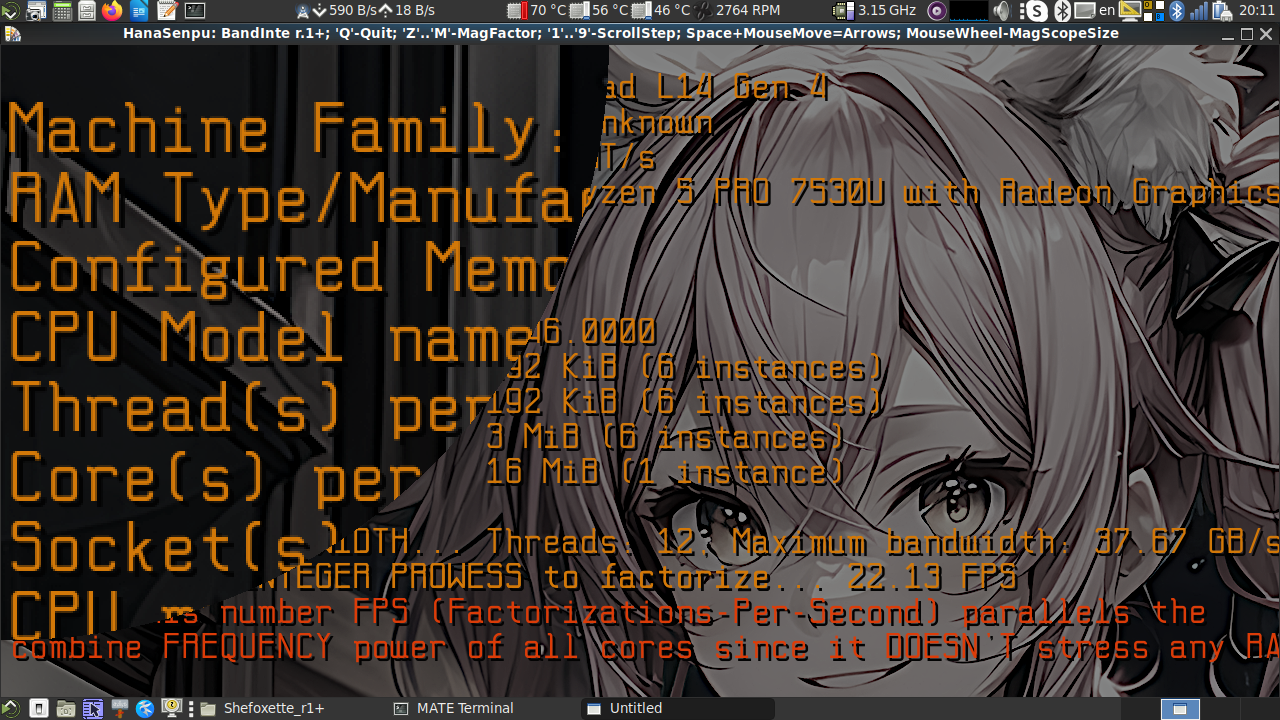Had to fix the stupid handling of mouse, so r2 is here.
Also, allowed the mouse-only (or trackpad-only) counterpart of Spacebar+Mouse.
Initially, didn't prefer holding LeftMouseButton and moving the mouse as a way to navigate/scroll the image because 2 problematic cases:
- not having mouse;
- some trackpads are not ergonomic enough (unable to handle well pressing-and-moving or even being unresponsive).
As always, the more the merrier, now either mouseless or ... mouseful one can easily zoom/scroll.
An old laptop (with 'Ivy Bridge') results:

It shows that 'Whiskey Lake' is a bit faster than 5 generations back. I have another Integer benchmark (which in contrast to the current Factorizer, stresses caches in schoolway multiplication digit by digit) which confirms that 8th gen is not significantly faster than 3rd, which in its turn confirms that FREQUENCY rules in simple scalar tasks.
Oh, my brother gave it a try on his (AMD Zen 3) laptop:

AMD site says that 7530U has 384KB L1 cache, but the actual size is 192KB instr and 192KB data, hm, never believe web-pages, run hardware readers.
The Factorization was much faster than I expected?!
These 3x boost is huge, it means that compression (a very common task) will be much faster also.
The Roster, so far:
Also, allowed the mouse-only (or trackpad-only) counterpart of Spacebar+Mouse.
Initially, didn't prefer holding LeftMouseButton and moving the mouse as a way to navigate/scroll the image because 2 problematic cases:
- not having mouse;
- some trackpads are not ergonomic enough (unable to handle well pressing-and-moving or even being unresponsive).
As always, the more the merrier, now either mouseless or ... mouseful one can easily zoom/scroll.
An old laptop (with 'Ivy Bridge') results:
It shows that 'Whiskey Lake' is a bit faster than 5 generations back. I have another Integer benchmark (which in contrast to the current Factorizer, stresses caches in schoolway multiplication digit by digit) which confirms that 8th gen is not significantly faster than 3rd, which in its turn confirms that FREQUENCY rules in simple scalar tasks.
Oh, my brother gave it a try on his (AMD Zen 3) laptop:
AMD site says that 7530U has 384KB L1 cache, but the actual size is 192KB instr and 192KB data, hm, never believe web-pages, run hardware readers.
The Factorization was much faster than I expected?!
These 3x boost is huge, it means that compression (a very common task) will be much faster also.
The Roster, so far:
Code: (Select All)
+-------------+-----------------------------+-------------+---------------------------+
| Submision | Machine CPU/RAM | Memory Read | Factorizations-Per-Second |
+-------------+-----------------------------+-------------+---------------------------+
| Sanmayce | ThinkPad L14 Gen 4 | 37.67 GB/s | 22.13 FPS |
| | Ryzen 5 PRO 7530U Zen 3 | | |
| | DDR4 ? MT/s | | |
+-------------+-----------------------------+-------------+---------------------------+
| Sanmayce | ThinkPad L490 | 30.11 GB/s | 7.54 FPS |
| | i7-8565U 'Whiskey Lake' | | |
| | DDR4 2400 MT/s | | |
+-------------+-----------------------------+-------------+---------------------------+
| Sanmayce | HP EliteBook 8470P | 21.04 GB/s | 7.12 FPS |
| | i7-3630QM 'Ivy Bridge' | | |
| | DDR3 ? MT/s | | |
+-------------+-----------------------------+-------------+---------------------------+
| Sanmayce | ThinkPad 11e 5th gen | 11.65 GB/s | 3.90 FPS |
| | Celeron N4100 'Gemini Lake' | | |
| | DDR4 2400 MT/s | | |
+-------------+-----------------------------+-------------+---------------------------+
"He learns not to learn and reverts to what the masses pass by."




